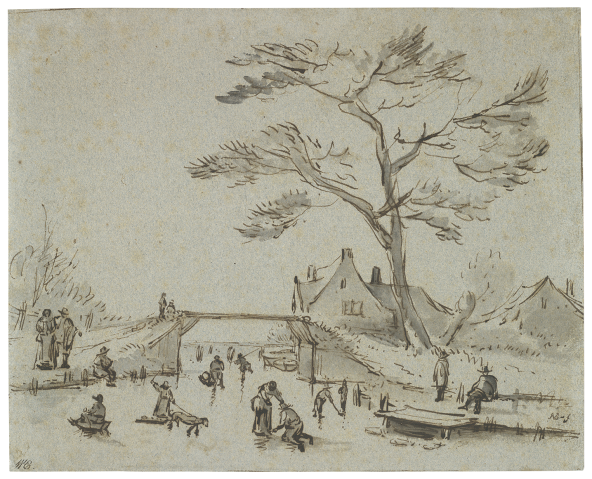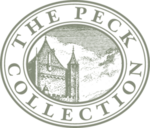Choose a background colour
Anthonie van Borssom, Dutch, 1631-1677
:
Broad River Landscape with Boats, c. 1650
Pen and brown ink on paper.
6 5⁄8 × 12 in. (16.8 × 30.5 cm)
Verso, at center in pencil, 14.
- Chain Lines:
- Horizontal, 24 – 25 mm.
- Watermark:
- None.
- Provenance:
John Spencer, 1st Earl Spencer, 1708 – 1746, Althorp (Lugt 1532, stamp on recto); by descent to his grandson, George John Spencer, 2nd Earl Spencer, 1758 – 1834, Althorp; probably his sale, Th. Philipe, London, 10 – 17 June 1811, no. 662 (as Rembrandt, A landscape — a river, or sea, perhaps the Haerlem Meer, with schuyts upon it, occupies the greater part of the scene — a CAPTIAL pen sketch); sale, Sotheby’s, New York, 26 January 2000, lot 30; Sheldon and Leena Peck, Boston (Lugt 3847); gift to the Ackland Art Museum, inv. no. 2017.1.10.
- Literature/Exhibitions:
Schulz 2002, 419, under no. 1178; Davies 2014, 25, 77, no. 75.
- Ackland Catalogue:
- 2017.1.10
This sketch, composed of swiftly applied and sometimes dry pen strokes, demonstrates how the artist divided this landscape into zones using diagonals to alternate areas of land and water toward the distant horizon line. It is a study for a finished painting, which he made in the manner of another Dutch artist, Aert van der Neer. As the only preparatory drawing for a painting that has come to light from Anthonie van Borssom’s body of work, it represents a valuable tool in understanding the artist’s creative process.
Anthonie van Borssom was a fascinatingly versatile artist, who could shift styles in his paintings and drawings in a chameleonlike fashion to partially adapt or even closely imitate the works of well-known artists of his day.1
He did so by creating his own inventions in their styles rather than copying their works directly. Although there is no firm evidence that he was a pupil of Rembrandt (1606 – 1669), it has often been suggested that he studied with him around 1645 – 50 given the similarities in style between Van Borssom’s landscape drawings, for which he is best known, and those by Rembrandt, his pupils, and close associates, such as Jan Lievens (1607 – 1674), Gerbrand van den Eeckhout (1621– 1674), and Philips Konink (1619 – 1688). On the other hand, he was also inclined to work in the styles of artists as diverse as Pieter Saenredam (1597 – 1665), Aert van der Neer (c. 1603 – 1677), and Adriaen van de Velde (1636 – 1672), none of whom had any artistic connection to Rembrandt and his atelier. It nevertheless remains tempting to posit him as Rembrandt’s pupil given his tendency to adopt a spare and even non-finito approach in some of his drawings, suggesting contact with the master that involved theoretical as well as practical matters.2
At first glance, this drawing brings to mind famous landscape etchings by Rembrandt from the late 1640s and early 1650s, such as Six’s Bridge and The Goldweigher’s Field, in which he managed to infuse the images with an airy and almost impressionistic sense of a rapidly caught moment.3
In 2002, however, Wolfgang Schulz pointed out that this drawing served as a preparatory study for a painting in the manner of Aert van der Neer that Schulz believed was painted by Van BorssomFig. 43.1.4

Anthonie van Borssom, Wide River Landscape by Moonlight. Oil on panel, 28.5. × 36.5 cm. Present whereabouts unknown.
Sotheby’s
This would make it one of several known painted imitations by Van Borssom of Van der Neer’s noted specialty, the moonlight landscape.5
In 2014, Alice Davies confirmed Van Borssom’s authorship of the present sheet in her catalogue of the artist’s drawings, noting that it must have certainly been a preparatory study for the painting.6
Although the majority of Van Borssom’s known landscape drawings are more fully worked up watercolors, a number of sketchier unsigned sheets like this one reveal his hand through the swiftly applied, broad, and sometimes dry pen strokes.7
Despite his protean nature, we have the benefit of understanding Van Borssom’s more cursory style though the fortunate survival of an intact sketchbook by him in the British Museum in which numerous examples of comparably sketched works can be found.8
The Peck drawing is one of only two by Van Borssom that relates closely to a painting. The other is a signed wintertime ice-skating scene on blue paper from the Abrams Collection in the Fogg MuseumFig. 43.2, which nearly matches the composition of a signed painting by Van Borssom in a Dutch private collection.9

Anthonie van Borssom, Winter Landscape with Skaters. Pen and brown ink, gray wash, on blue paper, 218 × 272 mm. Cambridge, Fogg Museum, The Maida and George Abrams Collection, gift of George Abrams in memory of Arthur DuBow, Harvard Class of 1954, inv. no. 2011.515.
The Maida and George Abrams Collection, Fogg Art Museum, Harvard University, Cambridge, Massachusetts, Gift of George Abrams in memory of Arthur DuBow, Harvard Class of 1954. Photograph © President and Fellows of Harvard College, 2011.515
As Davies noted, the Fogg and Peck drawings ostensibly offer us a chance to study Van Borssom’s working process from drawing to painting.10
The Fogg drawing, however, may have followed the related painting rather than preceded it, an alternative suggestion raised separately by both William Robinson and Mària van Berge-Gerbaud.11
The addition of washes lends it a more finished appearance, as does the use of blue paper (rarely used by the artist) and the presence of a signature. It might thus be an autograph copy of a successful composition that he generated for the collectors’ market, or perhaps even for the patron of the painting. Van Borssom made an autograph replica on one other known occasion, and the practice would have been in keeping with that of other artists in this period.12
The present drawing might thus be the only true preparatory study for a painting that has come to light in Van Borssom’s oeuvre. While certain motifs from his sketchbook can be found in his paintings, this sheet is a full compositional study, revealing the artist’s development of the complicated layering of diagonals that comprise the zones alternating between land and water. Whereas the Fogg ice scene is reduced in scale, the present work and its constituent elements more nearly match those in the similarly sized painting. Since there are no weather effects or cast shadows, just the gentle reflections of the sluice and boat in the water, the artist may have already had a moonlight landscape in mind as he worked up the drawing.
Davies catalogued over 170 drawings by Van Borssom, none of which bear a date, and neither she nor Werner Sumowski found it possible to develop a chronological framework for his corpus of drawings from a career that appears to have spanned three decades.13
Only a few of Van Borssom’s approximately thirty known paintings bear a legible date. None appears on a work that imitates Van der Neer, but we know that Van der Neer pioneered his moonlight paintings in the late 1640s and that they peaked in popularity in the early 1650s.14
A date for this drawing and related painting by Van Borssom likewise in the 1650s is proposed here, thus toward the outset of his career.
End Notes
For Van Borssom’s paintings, see Sumowski Paintings, vol. 1, 426 – 56. For his drawings, see Davies 2014; and Sumowski Drawings, vol. 2 (1979), 617 – 779. For an overview of his life and working styles (and concomitant issues of attribution), see especially Davies 2014, 13 – 18.
For an example of Van Borssom’s likely intentional exploration of non-finito effects, see, for example, the drawing in the Fondation Custodia, Paris (inv. no. 4540); and its discussion in Schatborn 2010, vol. 1, 117 – 18, no. 38.
New Hollstein (Rembrandt), nos. 222, 257.
Schulz 2002, 419, no. 1178 (entry for the painting, see also fig. 274), in which he calls the painting “probably by Van Borssom,” and the related drawing “possibly the preparatory study for the painting.” This drawing in any case bears no relation to the small corpus of twelve known drawings by Van der Neer; for which see Schulz, nos. D1 – D12.
For a discussion of Van Borssom’s imitations of Van der Neer’s moonlight paintings, see Schulz 2002, 42 – 44. The problems of attribution are compounded by the fact that later dealers sometimes added false Van der Neer signatures to Van Borssom’s paintings in his style.
Davies 2014, 25 (“Schulz’s claim that the drawing ‘possibly’ served as a preparatory study for the painting strikes me as too restrained.”), 77, no. 75.
For some examples, see Davies 2014, nos. 78, 91, 93, and 96 (Sumowski Drawings, vol. 2, nos. 336x , 348x, 288, and 287, respectively).
Davies 2014, nos. 122 – 77 (and introduction, passim). The sketchbook is composed of ninety-four individual sketches on fifty-six sides of forty-three pages. For a thorough discussion of the sketchbook, see the introduction and entries in Royalton-Kisch 2010, online.
For the drawing, see Davies 2014, 94, no. 110; W. W. Robinson in Greenwich 2011– 12, 126 – 27, no. 44; idem in Amsterdam, Vienna, New York & Cambridge 1991 – 92, 146 – 47, no. 64; and Sumowski Drawings, vol. 2, 696 – 97, no. 326. The painting is in the collection of Wilhelm J. A. Arntz, Wassenaar (Ice Skaters on a Frozen Pond, signed, lower right: AVBorssom fct., panel, 35.5 × 40.5 cm); see Davies 2014, 25, fig. 2.
Davies 2014, 25 – 26.
W. W. Robinson in Greenwich 2011 – 12, 126 – 27, no. 44; and Mària van Berge-Gerbaud in Paris & Ajaccio 2012 – 14, 62 – 63, under no. 13.
See Davies 2014, 26, nos. 11 and 16.
For the problem of chronology, see Davies 2014, 19; and Sumowski Drawings, vol. 2, 617.
Schulz 2002, 42 – 46.
